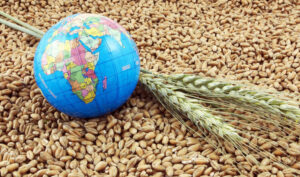
As of March 12, Ukraine exported 31.022 mln tonnes of grains and pulses since the beginning of 2024-2025 marketing year (July-June), of which 1.839 mln tonnes were shipped this month, the press service of the
Ministry of Agrarian Policy and Food reported, citing the data of the State Customs Service of Ukraine.
According to the report, as of March 20 last year, the total shipments amounted to 32.851 mln tons, including 3.181 mln tons in March.
In terms of crops, since the beginning of the current season, Ukraine has exported 12.509 million tons of wheat (526 thousand tons in March), 2.192 million tons of barley (48 thousand tons), 10.8 thousand tons of rye (0), and 15.839 million tons of corn (1.259 million tons).
The total export of Ukrainian flour since the beginning of the season as of March 17 is estimated at 51 thsd tonnes (2.5 thsd tonnes in March), including 47.1 thsd tonnes of wheat (2.4 thsd tonnes).

In February 2025, Ukrzaliznytsia (UZ) reduced the volume of grain cargo transportation to export destinations to 2,363.1 thousand tons, which is 496.3 thousand tons, or 17.4% less compared to January 2025, said Valery Tkachev, Deputy Director of the
Commercial Department, at a meeting of the UZ Exporters Office on Wednesday.
According to him, in February 2025, 2,171.0 thousand tons were transported to ports, which is 455.7 thousand tons, or 17.3%, less than in January this year, and 192.1 thousand tons were transported through land border crossings (40.6 thousand tons, or 17.5% less).
“Compared to February 2025/2024, the volume of grain cargo transportation in export traffic decreased by 28.5% (by 941.1 thsd tonnes),” emphasized the representative of UZ.
Mr. Tkachev noted that in January-February 2025, UZ transported 5,222.5 thousand tons of grain cargo for export, which is 1,448.2 thousand tons, or 21.7%, less than in the same period of 2024.
At the same time, 4 797.6 thsd tonnes were transported to ports in two months of 2025, and 424.9 thsd tonnes were transported through land crossings.
Therefore, the share of transportation volumes in the export traffic of grain cargoes in the direction of ports is currently 92%, and 8% by land.

As of March 3, Ukraine exported 29.202 mln tonnes of grains and pulses since the beginning of 2024-2025 marketing year (MY, July-June), of which 84 thsd tonnes were shipped this month, the press service of the Ministry of Agrarian Policy and Food reported, citing the data of the State Customs Service.
According to the report, as of March 4 last year, the total shipments amounted to 29.951 mln tonnes, including 270 thsd tonnes in March.
In terms of crops, since the beginning of the current season, Ukraine has exported 12.014 million tons of wheat (31 thousand tons in March), 2.126 million tons of barley (0), 10.8 thousand tons of rye (0), and 14.62 million tons of corn (53 thousand tons).
The total export of Ukrainian flour since the beginning of the season as of February 26 is estimated at 47.8 thsd tonnes (4.2 thsd tonnes in February), including 44.1 thsd tonnes of wheat (3.9 thsd tonnes).

IMC Agro Holding has added 150 grain carriers to its own railcar fleet, which now totals 300 cars, its press service reports.
According to the report, in 2024-2025, IMC invested about $22 million in grain cars.
“This railcar fleet will allow us to largely abandon leased railcars for the transportation of grain to ports,” IMC CEO Oleksandr Verzhykhovsky was quoted as saying in the report.
He added that, according to the agricultural holding, after the commissioning of this fleet, IMC will be able to transport up to 80% of the annual volume of grain grown with its own wagons, providing confidence in the timely execution of the railway component of export logistics and significantly saving on rail transportation.
IMC Agro Holding is an integrated group of companies operating in Sumy, Poltava and Chernihiv regions (north and center of Ukraine) in the crop production, elevators and warehouses segments. The Group’s land bank is about 120 thousand hectares and storage capacity is 554 thousand tons, with a harvest of 1.002 million tons in 2023.
In 2023, IMC posted a net loss of $21.03 million compared to $1.12 million a year earlier, and its EBITDA decreased 11.3 times to $3.22 million. Revenue increased by 22.3% to $139.45 million, while the share of exports decreased to 68% from 73% a year earlier.

As of March 5, Ukraine exported 29.68 mln tonnes of grains and pulses since the beginning of 2024-2025 marketing year (MY, July-2024 – June-2025), of which 490 thsd tonnes were shipped this month, the press service of the Ministry of Agrarian Policy and Food reported, citing the State Customs Service.
According to the report, as of March 8 last year, the total shipments amounted to 30.989 mln tonnes, including 1.319 mln tonnes in March.
At the same time, since the beginning of the current season, Ukraine has exported 12.155 mln tonnes of wheat (12.375 mln tonnes in 2023/24 MY), 2.126 mln tonnes of barley (1.761 mln tonnes), 10.8 thsd tonnes of rye (1 thsd tonnes), and 14.924 mln tonnes of corn (16.569 mln tonnes).
The total export of Ukrainian flour since the beginning of the season as of March 5 is estimated at 49 thsd tonnes (in 2023/24 MY – 74.9 thsd tonnes), including 45.2 thsd tonnes of wheat (71.1 thsd tonnes).

Ukraine is a strategic partner of the EU and the world. While a significant part of the world’s land is becoming unsuitable for agriculture due to climate change and soil degradation, in Ukraine, with a total area of 60.35 million hectares, 42.73 million hectares or 70.8% of the territory is already used in agricultural production, according to SEEDS.
Dmytro Ustavytskyi, co-founder of the logistics company NIDERA AGRO, an expert in international logistics and innovative solutions, and industry leader of the NGO Svit.UA, writes about this in a blog on the Svit.UA website.
“Despite the realities of the war, grain exports from Ukraine are crucial for the food security of the world. This month, the EU is presenting the updated Common Agricultural Policy of the European Union, which will be adopted in 2028. Currently, it is being discussed that trade preferences introduced in 2022 due to the war should be extended until 2027, as the war continues.
According to the Ministry of Agriculture, in 2024, exports of agricultural products brought in $24.6 billion, which is 59% of the country’s total exports. Ukrainian farmers managed to increase exports by 12.5% compared to 2023. Sales of grains (+1.1 billion USD) and oilseeds (+0.5 billion USD) increased the most,” says Dmytro Ustavytskyi.
In his opinion, logistics in the agricultural sector of Ukraine plays a crucial role in ensuring food security both domestically and in foreign markets.
“Logistics covers the entire supply chain – from the delivery of seeds, fertilizers and machinery to producers to the transportation of crops to storage, processing, domestic markets and export terminals. Efficient logistics helps to minimize crop losses, preserve its quality and ensure competitive prices,” adds the expert on international logistics and innovative solutions.
Challenges of war: infrastructure losses and risks
Russia’s full-scale invasion has shown the critical importance of stable logistics. The destruction of transport infrastructure, blocking of sea routes, destruction of elevators and mining of agricultural land have complicated agricultural processes. However, Ukraine was able to adapt by expanding export routes through the Danube ports and alternative land corridors to the EU.
Export potential: opportunities and constraints
The European Union remains Ukraine’s main trading partner. Ukrainian grain helps to reduce food inflation in the EU.
“However, neighboring countries view the Ukrainian agricultural sector not only as a partner but also as a competitor, which makes it difficult to enter new European markets. Therefore, the issue of extending trade benefits for exporters and solving the problems of blocking borders is a priority.
Ukraine has significant export potential because of its high quality products. For example, the President of the Ukrainian Grain Association (UGA) conducted an audit in the EU and received positive feedback on the quality of Ukrainian grain, which is recognized as one of the best in Europe,” recalls Dmytro Ustavytskyi.
How medium-sized farmers can enter EU markets
“Ukrainian farmers now have the opportunity to sell grain to the EU without customs barriers. For example, a farmer with 500 hectares of land can supply products directly to processors in Italy. And now Ukrainian grain can reach San Martino in Italy in just 2 weeks!
Currently, 90% of Ukrainian grain (wheat and corn) is supplied to Italy, gradually displacing Russian products from the local market. This demonstrates the effectiveness of Ukrainian logistics, which is gradually integrating into the European infrastructure,” emphasizes the co-founder of the logistics company NIDERA AGRO.
Development of logistics infrastructure: the key to competitiveness
According to the expert, his team has now built a complete logistics chain for farmers:
“Today, farmers have a choice – to sell grain on the domestic market or to export on more favorable terms. Transparency of prices on trading platforms allows us to plan sales more efficiently, which reduces logistics costs,” adds Dmytro Ustavytskyi.
Financial opportunities for exporters
According to the expert in international logistics and innovative solutions, farmers have already learned how to work with foreign exchange contracts, which simplifies export operations. Banks have simplified the mechanism for servicing foreign currency accounts, which helps to avoid exchange rate risks.
“However, exports require certification and professional support. We help small producers to go through this process without risks by providing solutions for exporting consignments of 1,800 tons or more. Quality assurance is a key factor in successful exports,” says Dmytro Ustavytskyi.
Trade strategies and training for farmers
One of the common mistakes, the expert believes, is selling grain immediately after harvest, when prices are lowest. In his opinion, it is more profitable to store products and analyze the market to sell at the most favorable time.
In addition, further improvement of agro-logistics is impossible without investment in:
“At NGO Svit.UA, we are raising these issues and will be organizing meetings with the Ministry of Agrarian Policy to discuss the possibilities of state support for small and medium-sized farmers in entering international markets.
In times of war, export support for small and medium-sized farmers is becoming a strategically important area for food security and economic development.
Ukrainian producers remain important partners for the EU, so there must be a certain trade culture, because the main requirement of European buyers is honesty in terms of quality and quantity of products,” adds Dmytro Ustavytskyi.
In his opinion, Ukraine has unique opportunities to integrate into the European market even despite the challenges of war. Investments in logistics, digital solutions and international cooperation will help make this process efficient and profitable for Ukrainian farmers.